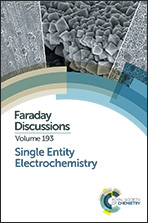On the mechanism of electrochemical vesicle cytometry: chromaffin cell vesicles and liposomes†
Abstract
The mechanism of mammalian vesicle rupture onto the surface of a polarized carbon fiber microelectrode during electrochemical vesicle cytometry is investigated. It appears that following adsorption to the surface of the polarized electrode, electroporation leads to the formation of a pore at the interface between a vesicle and the electrode and this is shown to be potential dependent. The chemical cargo is then released through this pore to be oxidized at the electrode surface. This makes it possible to quantify the contents as it restricts diffusion away from the electrode and coulometric oxidation takes place. Using a bottom up approach, lipid-only transmitter-loaded liposomes were used to mimic native vesicles and the rupture events occurred much faster in comparison with native vesicles. Liposomes with added peptide in the membrane result in rupture events with a lower duration than that of liposomes and faster in comparison to native vesicles. Diffusional models have been developed and suggest that the trend in pore size is dependent on soft nanoparticle size and diffusion of the content in the nanometer vesicle. In addition, it appears that proteins form a barrier for the membrane to reach the electrode and need to move out of the way to allow close contact and electroporation. The protein dense core in vesicles matrixes is also important in the dynamics of the events in that it significantly slows diffusion through the vesicle.
- This article is part of the themed collection: Single Entity Electrochemistry

 Please wait while we load your content...
Please wait while we load your content...